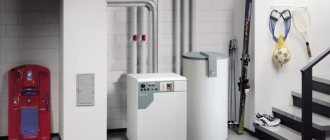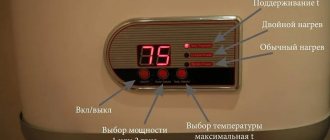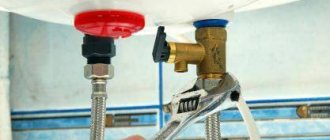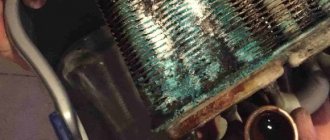Situations when the water heater stops turning on are not uncommon and are always unpleasant. You can try to fix the problem, but first you need to figure out the reasons.
So, in front of you is a seemingly functional boiler, but it does not heat the water, and no light bulbs, sensors or displays work. You can determine why the water heater does not turn on only by disassembling it. But before that, you should still check the presence of current in the network - the wire may be damaged, the socket or plug may fail.
Naturally, in this case the water heater will not work, although the device itself will not need repair. Just connect any other working device - and you will see if the outlet works. Emergency operations on the panel cannot be ruled out - if the water heater is used simultaneously with other powerful appliances in an apartment where the wiring is not designed for such a load.
Why doesn't the boiler turn on?
Boiler Termex
One of the Termex models
Probable sources of problems:
- Triggered RCD (residual current device). First, check the serviceability of the RCD itself; this is done by pressing the “test” button on the device. When in good condition it will turn off.
- The mounting of the heating element (tubular electric heater) or the heating element itself is not in order.
- The water purification filter is faulty. Needs to be replaced with a new one.
- The temperature sensor is broken.
- No electricity. This is the most common cause of breakdown. Great care must be taken with the cable running from the shield to the mechanism.
- The pressure measuring device has failed. Frequently changing pressure wears it out. You'll have to buy a new one and install it in the boiler.
- Broken socket.
Important! If the power of electrical appliances is more than 3 kW, it is necessary to have a cable with a cross-section of more than 3.5 mm². Only such a cable will withstand the load, and the device will function without interruption.
Once a year, the boiler owner needs to do routine cleaning and replace worn parts. This will extend the life of the boiler.
Boiler Ariston

One of the Ariston models
Water heaters of this brand do not turn on for similar reasons:
- No power supply. You need to check the quality of the cable using a tester.
- Broken socket.
- RCD failure. To check its operation, you need to press the RESET button on the device. If the indicator lights up, then there is power. Then you need to press the TEST button, the indicator will go out, and RESET again. The indicator lights up - the RCD is working properly. If the RCD is working correctly, then it has responded to another serious problem in the electrical network.
- Faulty heating element. It breaks down due to a thick layer of scale that appears if the magnesium anode is not changed on time. This must be done at least once every two years.
Do-it-yourself instantaneous water heater repair
Place a deep container under the tank; residual liquid may spill out. Using a wrench, unscrew the nut counterclockwise. For convenience, the housing can be removed from the wall and installed upside down. Now you can remove the heating element
Remove it from the housing - proceed carefully so as not to damage the element. If the part does not come out due to scale, clean the hole a little using a plastic knife
Economy class This is a more modern technology. To remove the cover, you need to unscrew two bolts. They are located near the inlet and drain hoses. You can remove the thermometer by pulling it down, but the movement must be quick and precise.
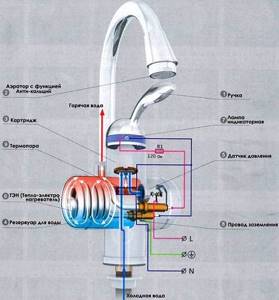
A special nut secures the flange strip. Unscrew it and remove the flange.
How the boiler works
Before removing the part, spin it. Remove the cover. Remove the temperature sensor. First disconnect the contacts from the heater. Remove the flange bolts using a socket wrench.
Unscrew the cap nut. Remove the plastic shields. Where can I find or what do the instructions for this Ariston boiler look like?
An electric instantaneous water heater can function fully in your home
Great article, but you just can’t copy it. Yes, that's understandable. The article was not prepared by people - aliens. And they are rednecks.
Tell me what the problem might be: the water heater heats up, draws water, but hot water does not flow from the tap. I took everything apart, cleaned the boiler and filters - still no leaks. Cleaning didn't help. How to find out the reason for the breakdown of the heating element or relay?
Causes of problems
Electronics are quite sensitive even to minor external influences. Malfunctions occur as a result of the following actions:
- Unstable voltage in the electrical network. To protect all electrical appliances, you need to install a special relay to limit the voltage.
- Mistakes of owners who do not carry out regular preventive maintenance.
- Incorrect installation of the boiler leads to early failures. Because of them, even a high-quality device quickly breaks down.
- A deposit of scale and salt has formed on the surface of the storage tank on the thermal elements. This is due to the high temperature, no higher than 60 degrees is considered acceptable. If the water is hard, it is better to install a filter to purify the water at the inlet. Manufacturing defects are very rare, and even more rarely they appear immediately.
- Small damaged and consumable parts were not replaced with new ones. This caused even bigger problems.
Types of malfunctions and their causes
There are many reasons why boilers fail. Most of them can be fixed on your own. Main problems:
- The device does not heat water. The reason may be a failure of the heating element or the electrical system. If the heating procedure takes longer than usual, this indicates multiple scale that needs to be removed. In addition, due to deposits, the boiler may turn on/off more often.
- Overheating of water is a consequence of a broken thermostat.
- A leak from under the flange indicates damage to the container due to mechanical action or metal corrosion.
- If the device is constantly noisy, there may be a lot of scale on the heating element, or the check valve is broken.
- The display shows an error. Some devices are equipped with an electronic system that may malfunction due to power surges or module failure.
- Lack of hot water supply indicates a breakdown of the heating element or thermostat.
- Dark-colored hot water indicates the presence of corrosion, which can be caused by hard water. If the tank is damaged, you will likely need to purchase a new unit.
- The heater produces an electric current. This situation can happen due to damage to the cable or rupture of the heating element.
- The device does not turn on or off - the reason is burnt out contacts or melted buttons.
- Constant burnout of heating elements is caused by a large amount of scale or improper installation of the device.
- If air appears in the water heater, it means the gaskets are worn out or the check valve is broken.
Replacing the heating element or anode
If the temperature sensor or heating element has burned out, it is time to replace the magnesium anode. First you need to disconnect the device from the power supply, then:
Remove the plastic cover and disconnect the wires. Turn off the cold water supply and disconnect the pipes. Unscrew the mounting screws and remove the protective cover. Remove the temperature sensor and flange. Remove the heating element carefully so as not to damage the rubber gasket. Remove the appliance from the wall, place it in the bathtub, and then run a water hose inside to remove any remaining scale. To clean the heating element, stir 50 g of citric acid in 2 liters of water. Keep the heating element in the resulting solution until the deposits dissolve (10-12 hours). Unscrew the magnesium anode and assess its condition. If one pin remains, replace the part. After cleaning, return the parts to their place. If necessary, install a new temperature sensor. Reassemble the structure in reverse order
Particular attention should be paid to the condition of the rubber gaskets. If they become unusable, it is recommended to replace them with new ones to avoid leaks of the product after assembly. The product must be connected to the electrical network after it is completely filled with water.
Repairing leaks
If water drips from the device, the reason may be worn sealing gaskets or damage to the container. In the latter case, repairing heating tanks does not make sense; the purchase of a new device is required. If the problem is in the rubber seals, you need to replace them with new ones.
During installation of the water heater, specialists install shut-off elements. A check valve is installed at the cold water inlet, which is adjusted during operation of the system.
The safety valve is placed on the cold water supply pipe, following certain recommendations:
- It is forbidden to install shut-off valves between the valve and the boiler.
- For a flexible hose, you need to make a special hole in the sewer pipe.
- To quickly drain water from the device, it is permissible to install a ball valve with a tee.
- A leaking valve may indicate its failure. Complete replacement of components will help correct the situation.
- Another cause of leakage can be excessive water pressure. To prevent this, it is optimal to install a regulator that reduces the readings to normal.
How to fix a breakdown
Termex and Ariston boilers are repaired using the same methods.
In most cases, the boiler does not turn on due to problems with the heating element. It is secured with 6 bolts, they need to be unscrewed and the heating element removed. It is possible that he has become slightly stuck and will not give in immediately. Once it is disconnected, you need to thoroughly clean the device. Now you can check its operation with a tester. Instructions for verification are given in the next section. All repairs consist of replacing the old heating element with a new one.
Next you need to clean and wash the boiler tank. As soon as it dries, you can begin installing a new heating element and magnesium anode. To make the element last longer, it is recommended to add a water filter to the water heating system. Also, you should not heat the water more than 45 degrees.
There is no power supply to the water heater. A connecting cable runs from the shield to the mechanism. You can find out whether the cable is damaged or not using a tester. If it is normal, then the device will not show phase and zero. The faulty wiring must be replaced with a new one and routed from the switchboard.
Pressure and/or temperature sensors are broken. Can be checked using a tester. In case of malfunction, replace with a new one.
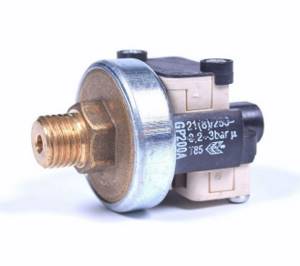

Pressure sensor and temperature sensor
Water pressure too low. Each Thermex device has its own operating pressure specified in the instructions. The owner needs to buy a pump and install it in the boiler. You can also hang the water heater lower than it is currently located on the wall. It is possible that some contacts have come loose, burned or oxidized. They either need to be tightened or cleaned. If they still don't work, they will have to be replaced completely.
Faulty socket. You can connect another device to it to check its operation. A broken socket must be replaced with a new one. It must be selected in accordance with the power of the boiler. It is also worth making sure that the ground is properly connected to the power outlet. If the connection is incorrect, the RCD may not work, causing the boiler to break. A residual current device is necessary in case of increased voltage in the network and burnout: it will turn off the water heater in time.
A broken RCD can also cause a malfunction.
Detailed instructions for checking and repairing heating elements and RCDs can be found in the following sections.
How to disassemble a water heater with a heating element
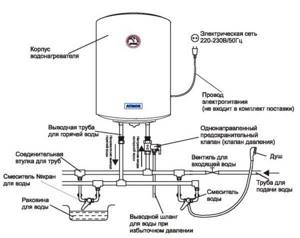
Diagram of an electric flow heater.
This is a relatively inexpensive type of boiler that has a heating element attached to nuts. This device, as a rule, does not have external adjustment. Its distinctive feature is the presence of a hexagonal flange, which can be unscrewed with a 55 wrench or a regular gas wrench.
Algorithm for disassembling a water heater with a heating element:
the device is disconnected from the network, the water is drained and the check valve is dismantled, which will only complicate the work; the boiler cover is removed, which is screwed closer to the pipes; The thermostat is being dismantled; place a container under the water heater into which the remaining dirt, water and scale will be drained; unscrew the flange counterclockwise (existing dirt and scale can complicate the work, so they are carefully cleaned off with a wooden or plastic knife; as soon as the thread ends, the flange is carefully removed); in order to remove the heating element, remove the scale from the bends of the heating element and, carefully swinging it left and right, pull out the lower part of the element.
How to disassemble an economy class water heater (boiler) Economy class water heaters are distinguished by an oval flange shape, therefore the principle of their disassembly has some peculiarities.
Stages of disassembling an economy class boiler:
- the device is disconnected from the power supply, the water is drained and, if necessary, the check valve is unscrewed;
- There are two screws near the drain and fill pipes that should be unscrewed and the water heater cover removed;
- with a sharp downward movement, the thermostat is removed and access to the flange is opened, which is attached with a nut to the body using a strip; After the nut is unscrewed, you can remove the flange.
How to disassemble a medium-class water heater Medium-class water heaters have an average price category. The device comes with flanges that are attached directly to the neck using 6 bolts.
The disassembly process for this water heater is as follows:
- the power supply to the device is turned off, the water is drained and the check valve is removed;
- to remove the cover, find the screws and unscrew them (the location of the screws may vary);
- after this, it is necessary to remove or remove the thermostat (depending on whether it is connected to the heating element with a wire or inserted into it);
- all necessary screws or nuts are unscrewed.
How to check electrical elements and heating elements
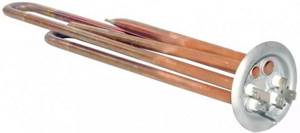
Heating element of the Termex boiler
One of the most common reasons why the boiler does not turn on is a broken electric heater. It fails in the following cases:
- the filament inside the heating element has burned out;
- there was a short circuit in the incandescent wire, so the electric boiler received an electric shock;
- a thick layer of scale has appeared on the heating element, so heat exchange is impossible, and the water heats up less and less with each use.
To check the heating element, you must remove it from the water heater. Then the device needs to be descaled. Now you can carry out a full inspection for cracks, holes, swelling and other defects. If there is such damage, then repairs will cost more than buying a new heating element. If there are no visual defects, you need to ring it using a tester.

Checking the heating element using a multimeter
Checking for serviceability is carried out in two ways:
- It is necessary to check the nichrome thread, which creates the glowing process. The tester is set to circuit test mode. It is necessary to check whether the nichrome thread, which ensures the incandescence process, has failed. To do this at home, the tester must be set to circuit test mode. The terminals of the device must be connected to the contacts at the base of the heating element. If the arrow is at zero, the thread is fine. If the arrow is not at zero, then the thread has broken and the heating element will have to be completely replaced.
- It is necessary to check the closure of the spiral. You only need to connect one terminal of the tester to the heating element. The other contact must be attached to the water heater tank. If the device shows a target, it means that the coil is resisting the boiler insulation. Therefore, the spiral touches the body. The heating element needs to be changed.
Ariston boiler analysis
Disassembly of Ariston boilers must be carried out according to a special algorithm, taking into account some features of the device, primarily the oval flange. Thus, the preparatory stage includes the well-known power outage, as well as the draining of water necessary for further analysis. It is also possible to remove the check valve if dismantling requires it. (See also: How to make a boiler with your own hands)
The subsequent actions are similar to the established algorithm for disassembling water heaters. That is, you need to unscrew the bolts located below and remove the cover. The thermostatic device is released with a slight downward movement. Removing this equipment allows access to the flange. Ariston boilers secure the flange with a nut and a strip, so its removal will only be possible after removing these fasteners
It is important to remember that the removal of the heating element and flange is carried out by first turning the heating element down. The same algorithm of actions must be performed to assemble a disassembled boiler
The device is cleaned using all known methods, including chemical action of special agents, or mechanical action with a stiff brush.
It is very important to take into account the asymmetrical flange shape when reassembling the unit. In order to avoid problems with reassembly, it is best to remember the location of the flange in the neck
You can choose the terminal as a reference, since its position is much easier to remember. It often happens that after disassembling the unit begins to leak, in this case it is recommended to change the rubber gasket in advance.
Construction of gas water heaters
To repair any equipment, you need to know its design features.
For municipal and domestic needs, gas water heaters of 3 main types are used:
- accumulative;
- flow-through;
- combined.
The most popular are gas instantaneous water heaters. Abbreviated as GPVN. GOST defines them as instantaneous water heaters. In such devices, water is heated only when the tap is turned on.
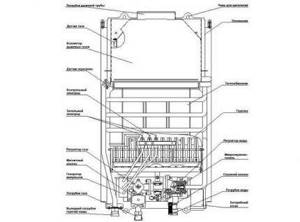
The standard HPGV circuit includes many elements grouped depending on the functions performed: gas path, combustion path, water circuit, etc. For example, burners belong to the gas path, and the heat exchanger belongs to the combustion path
Technical requirements for household instantaneous gas water heaters equipped with atmospheric burners are established by GOST R 51847-2009. Their classification is also given there.
